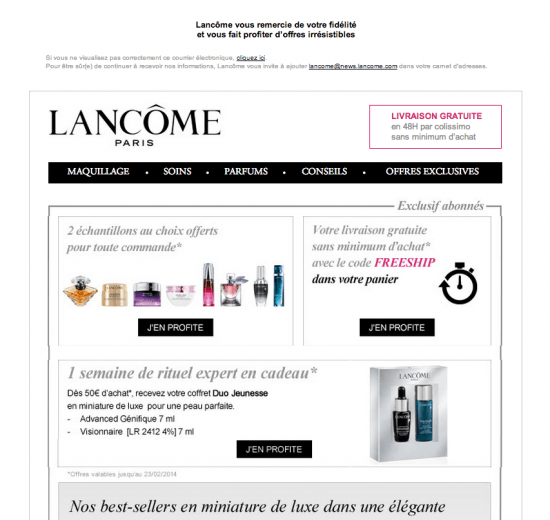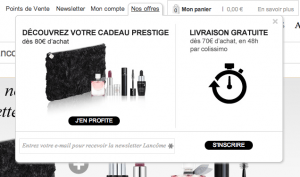This year is supposedly all about Big Data. However, many — if not most — brands are far from actually capitalizing on the opportunities in Big Data. I wanted to highlight an erroneous campaign by a rather large brand, that ordinarily one would think should know better. While the campaign below relates to loyalty marketing (which I encourage), it deals with a classic case of lazy marketing.
Lazy marketing
The email “newsletter” below, which I received last week, is from Lancôme. In case you don’t know it, Lancome is an upscale cosmetics brand, part of the “Luxury Division” of L’Oreal*. It’s the crown jewel of that division. In terms of providing a fulfilling luxury CRM experience, most brands struggle with the equilibrium between personalization and efficiency. Lancome, in particular, seems to struggle with small data, much less big data. A few things struck me about this mailer, which smack of lazy marketing. You will have to bear with me as the mail in question is in French (from Lancome France), but I have translated the key components.
- The first issue I had with this “newsletter” is that they have incorrectly included me as a part of the loyal customer bucket. Neither I or my wife are clients. The title of the email was “Merci” or thank you. Hardly, audience appropriate as far as I was concerned. The small print at the head of the mail said that I was being thanked for my loyalty with an “irresistible” offer.
- The second point is that Lancome has never made any effort to know more about me or to convert me. All the product on display in their newsletter suggests that they believe I am a woman (CRM = Can’t Remember Me) — whereas they do have a men’s line. With a send rhythm of around every 3-4 days, Lancome would seem to be spinning the wrong wheels. Having been on this mailing list for several years, there has obviously been no effort to “clean” up the database. With such an email strategy, one must imagine that the open rate is gradually but surely diminishing.
- A third fly in the proverbial ointment relates to the Free Shipping offer. On top right, they write “free shipping without a minimum purchase” and then below repeat the same message, except with the need for a code (confusion). And then…
Once I went on the site, I encountered the message below, saying that I get a free delivery with a purchase of over 70 euros.
So which is it? I’m thinking. I am clearly not a loyal customer of Lancome. Nor am I a woman. Finally, what is the irresistible offer for me. The good news is that I believe that focusing on one’s loyal customers is absolutely vital to long-term health in this digitally connected world. The bad news is that, if you can’t truly segment and treat your loyal customers differently than your regular customers (not to mention non customers, such as myself), then the loyalty marketing efforts will have a long way to go to succeed. When you compare Lancome’s one-mail fits all approach to the way Gilt, the luxury flash sale site based in the US, segments its mailing list into over 2,000 different buckets, it is clear that they have a long way to go to understand, much less master, big data/small data/smart data (call it what you will!).
3 steps to great loyalty marketing
Saying thanks and appreciation to your loyal customers is, of course, a great idea. However, loyal customers merit specific communications. Each luxury brand must craft a unique answer and style, depending on its context and business objectives. Nonetheless, below are three aspects I believe a luxurious loyalty marketing program should incorporate:
- Think customer first – The uniting factor in both the CRM / email strategy as well as the user experience (or customer experience) online is the need to think customer first, to put the customer in the center. Notwithstanding a very product-centric approach, Lancome’s online presence and emails speaks to a non-personalized approach, much less lacking in customer centricity. Thinking customer first means figuring out how to make each communication as pertinent as possible for the recipient, in a contextually relevant manner.
- Luxury user experience – Nothwithstanding the misnomer of considering a customer as a user, luxury brands need to craft a unique statement in their UX, all the while ensuring that the basic functions (search, load up, payment…) are benchmarked against best in class. {Tweet This!} When I plowed further into Lancome’s site, I was intrigued by the fact that under “Keep Me Informed” they had a Blog and Facebook page. Outside of the poor UX, where they don’t have a hyperlink on the thumbnail images, I was quite surprised to find an English-speaking blog on the French site. Aside from the blog being updated only sporadically, I suggest putting an English language flag beside the word blog to ward off disappointment. A luxury user experience is rooted in the details.
- Lead with utility – Especially in a luxury environment, it would be significantly more powerful to provide valuable or useful information. In a world where trust of marketers is low, luxury brands should be a cut above (forgetting the issue of sending a newsletter where the four calls to action are related to deals). If the Lancome blog is only in English, maybe it would be appropriate to promote some (French language) videos on its YouTube channel with sound advice (naturally, with targeted videos that are adapted to the recipient). Show that you intend to add value, before offering deals!
What do you think? Do you read Lancome’s strategy in the same way? Any other similar examples you ‘d like to share, please do!
*Full disclosure: I worked at L’Oreal (Professional Products Division) for 16 years.












